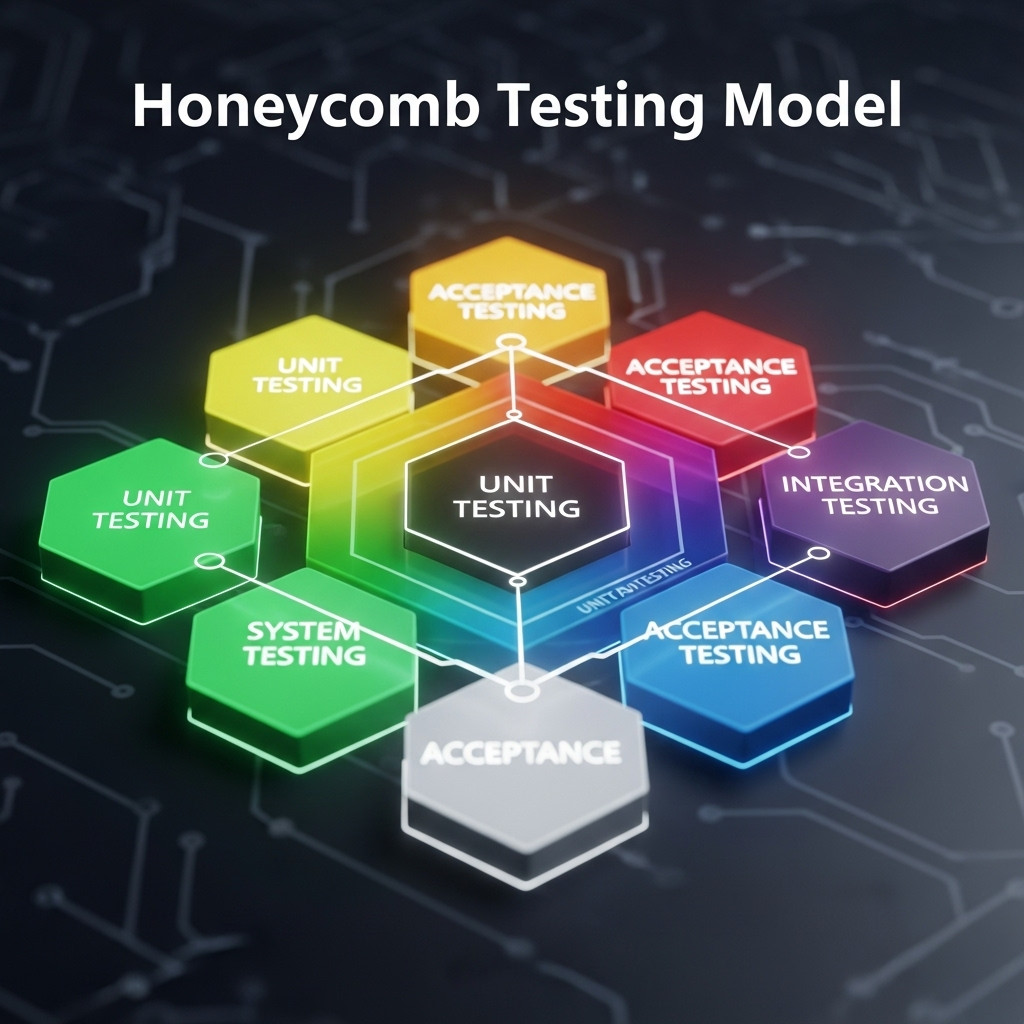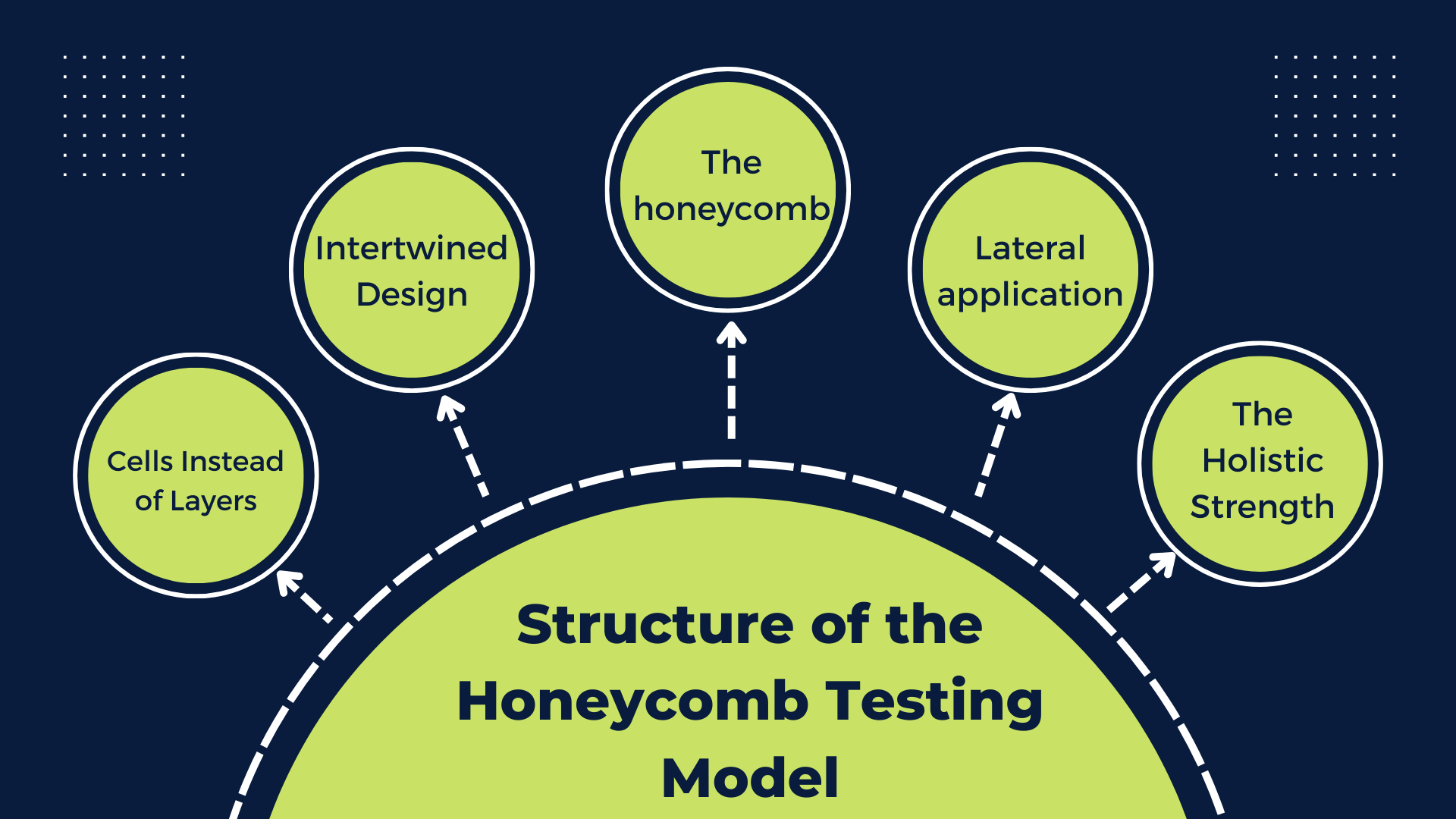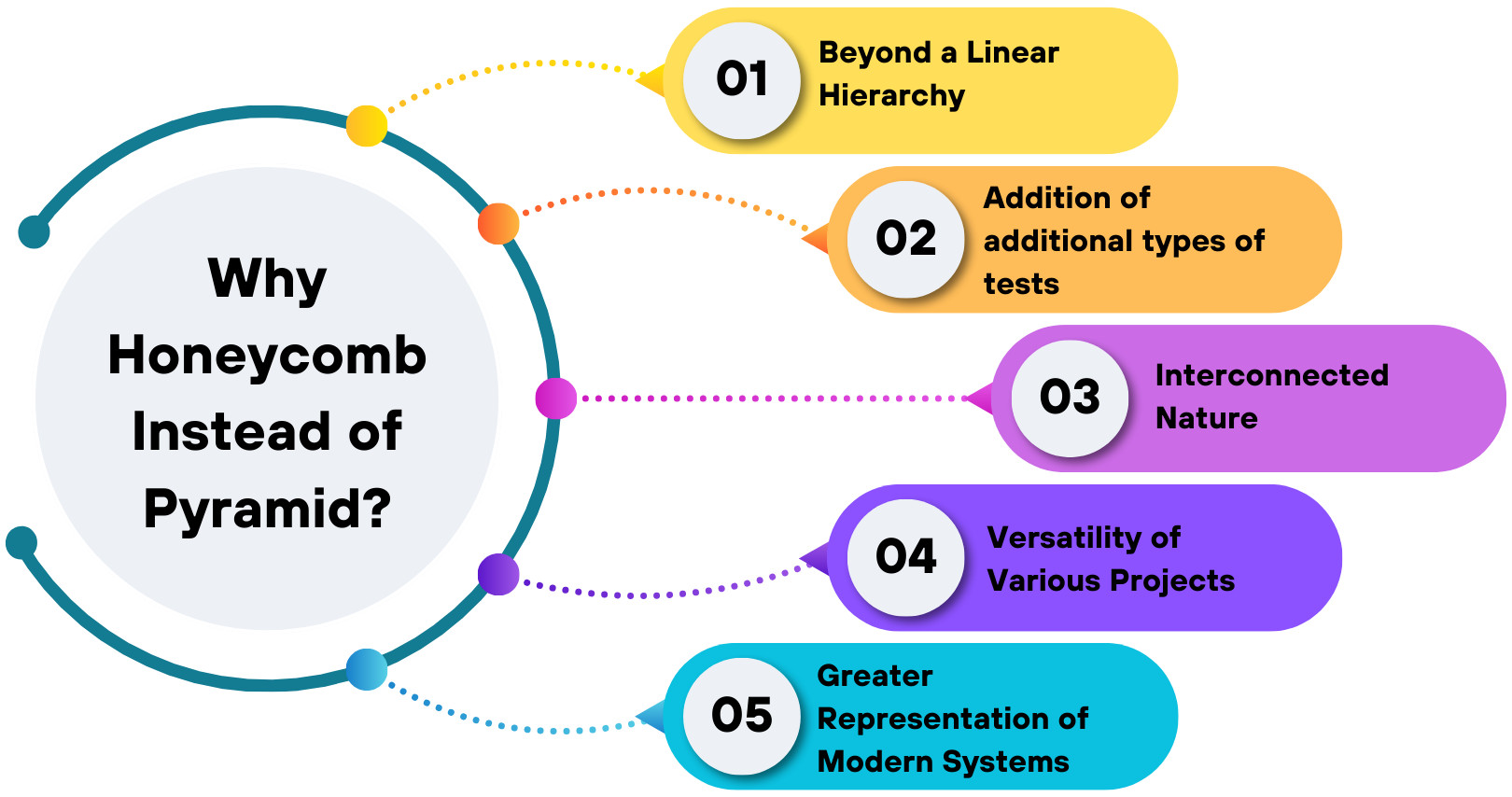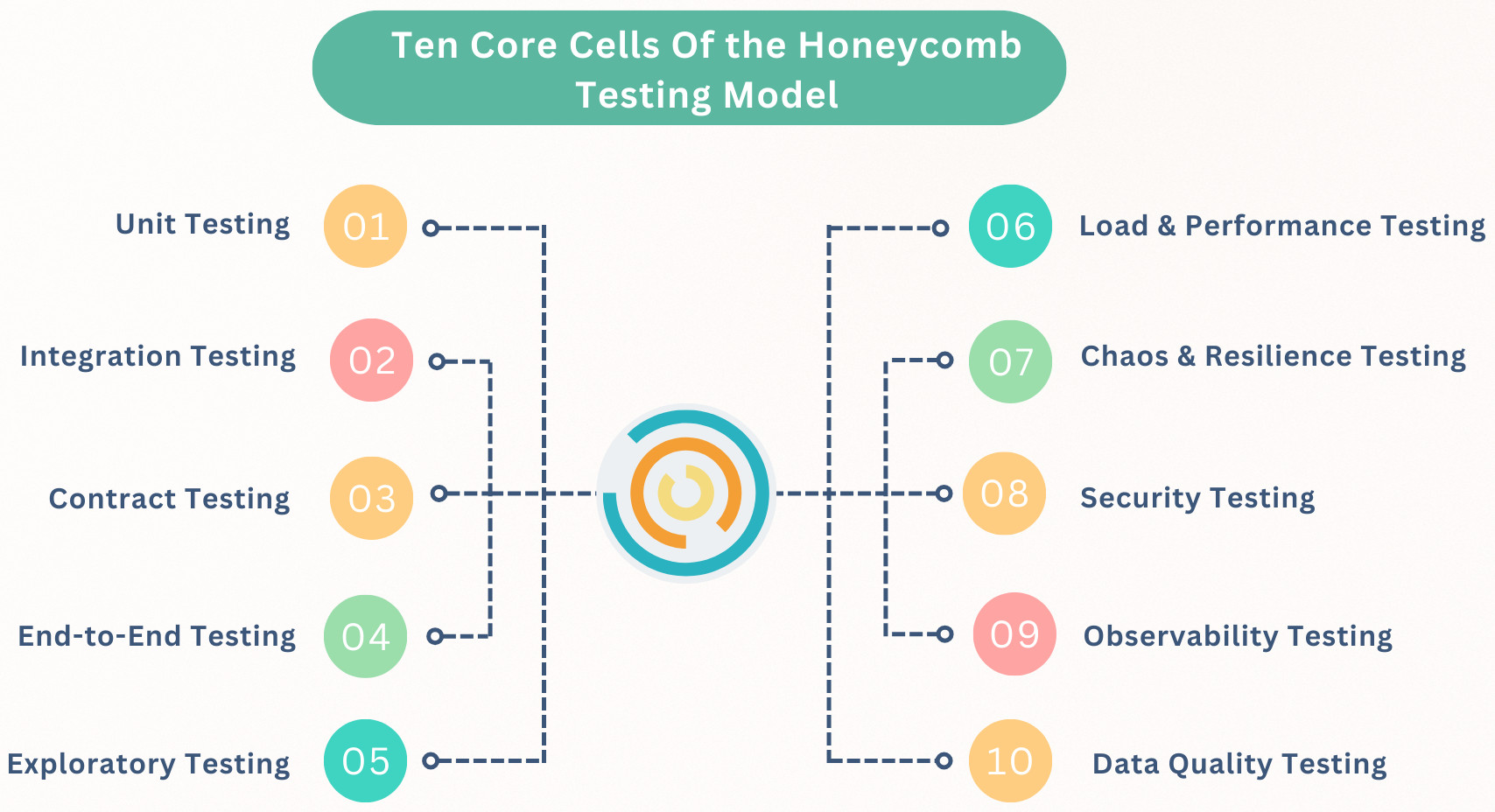What is the Honeycomb Testing Model?
|
|
Testing in modern system development has exceeded the task of verifying the correctness of the code. The current applications are distributed, interconnected, and data-driven, and this implies that testing has to address a broader scope of issues, including functionality, performance, resilience, security, and data quality.
Classic frameworks, such as the Testing Pyramid, will supply an initial point of view, although they do not always accurately reflect the reality of more modern systems. In an attempt to express such a larger picture of testing, the Honeycomb Testing Model was proposed. The honeycomb structure emphasizes various kinds of cell testing that can collaborate to improve software quality. These cells correspond to dimensions of testing unit, integration, contract, performance, security, and many others that indicate that quality is about numerous connected, interconnected pieces instead of a layering technique.
Through the Honeycomb approach, organizations will be in a better position to align their testing strategy to respond to the demands of complex, modern systems.
| Key Takeaways: |
|---|
|

What is the Honeycomb Testing Model?
Honeycomb testing model is a new method of software testing that extends the pyramid-style. Other than layering tests atop each other, it maps out testing as a honeycomb composed of various compartments. The cells specialize in one kind of testing and when combined they make up an entire, self-contained, and interrelated system of quality control.
- Visual Structure: The model resembles that of a honeycomb, with each of the hexagonal cells being a testing activity (unit testing, integration testing, contract testing, security testing, or data quality testing).
- Holistic View: As compared to the pyramid, which is primarily limited to code-level tests and system-level tests, the honeycomb tends to acknowledge that contemporary systems need verification on a wide variety of dimensions beyond resilience, observability, and performance.
- Practical Purpose: The model motivates the team to diversify effort into several places of testing as opposed to the unit approach that concentrates on one-unit tests or extreme to end tests. This equilibrium facilitates the chances of identifying the problems at an early stage and in varying angles.
- Result: An extensible, more general-purpose approach to testing that is more applicable to modern distributed systems, microservices, and data pipelines.
The Origin of the Honeycomb Testing Model
The honeycomb testing model was developed to solve the problems of previous desired testing models, such as the testing pyramid. With the growth in size, distribution, and complexity of software systems, a different approach to thinking about the testing process was necessary, and this approach was needed to account for the diversity of testing checks that are demanded by modern applications.
- Simplicity to Complexity: Testing pyramid was effective during a time when applications were huge and simpler in nature, but did not reflect testing requirements in microservice, cloud, and data-driven systems. The honeycomb model arose to give a larger picture.
- Based on the Real-World Challenges: Teams have experienced that the inability to test everything end-to-end and at the unit level has left significant vulnerabilities in key domains such as the security, performance, and resilience. The honeycomb was developed to cover these dimensions that were neglected.
- Community Influence: The model became popular with practitioners who required a visual approach to testing beyond a code level testing approach. The introduction of cells in the various testing regions assisted the teams of the organization to strategize their testing process more efficiently.
- Symbology of the Honeycomb: Honeycomb was selected as a symbol since it is a logo of strength developed out of many unified components. Just as it is in nature, individual cells add up to form a structure. In the testing this implies that no form of testing alone is sufficient – quality is the amalgamation of all.
- Change of Thinking: In a wider context, the origins of this model is indicative of a wider trend in the field of software engineering: a departure of such narrow test hierarchies to instead integrated systems of assurance which are more attuned to emerging modern architecture.
Structure of the Honeycomb Testing Systems
The honeycomb testing model is conceptualized based on the notion that the quality of software is multidimensional, with its various aspects interoperating. Rather than a vertical stack, it is shown in the form of a honeycomb composed of hexagonal cells, each of which symbolizes a particular type of testing. These cells collectively grow into a strong and intertwined structure.

- Cells Instead of Layers: Tests are not tiered like the pyramid, tests are evenly distributed as cells in a honeycomb structure. This indicates that there is no one particular form of test that is highly significant when taken standalone-strength lies in their amalgamation.
- Intertwined Design: All testing cells are linked. As an example, integration and contract tests consume unit tests, but chaos and performance tests are supported by observability testing. The relationships focus on the cooperation of the types of tests.
- The Honeycomb: Cross dimensional tests: The honeycomb extends the classical functional tests. It also takes such domains as performance, security, observability, resilience, and data quality that are critical in the modern distributed systems.
- Lateral Application: The teams may also focus on any cell more according to the project requirements. An example is, a financial system that may focus more on security and quality of data, whereas a consumer application may focus more on usability and performance.
- The Holistic Strength: The model depicts that like a natural honeycomb the strength is in the form of balance. The combination of tests provides reliability and the loss of one decreases the quality of the structure overall.
Why “Honeycomb” Instead of “Pyramid”?
The honeycomb testing model was picked up as a substitute for the pyramid, as it is more realistic about the actual facts on the ground in software testing. Although the pyramid was basic and handy in the past, it can no longer support the existing complex systems today. The honeycomb shape provides a more natural and freer form of thinking concerning the testing.

- Beyond a Linear Hierarchy: The pyramid implies a strict top-to-bottom hierarchy, but contemporary testing is not always linear. The honeycomb reveals various levels of testing that could be performed in parallel and affect one another.
- Additional Types of Tests: The pyramid is primarily concentrated on unit, integration, and end-to-end tests. The honeycomb introduces new domains of performance, security, observability, and data quality that are also essential in distributed systems.
- Interconnected Nature: Tests are not isolated, as demonstrated in the honeycomb, where each of the cells is intertwined with others. For example, contract testing helps in integration testing, observability testing enhances resilience, and performance testing. In the pyramid, we lack this interdependent perspective.
- Versatility of Various Projects: The pyramid provides the model of a one size fits all but with the honeycomb, groups are free to focus one cell over another based on the demands of the system. A startup can be much more speed and functionality-centred whereas an enterprise system can be more security and resilience-oriented.
- Greater Representation of Modern Systems: As an analogy, a honeycomb in nature is robust because of numerous interconnected cells; the honeycomb testing model represents quality by a combination of many different types of tests rather than simply stacking tests.
Ten Core Cells Of the Honeycomb Testing Model

Unit Testing
The purpose of unit testing is to validate small units of code in isolation. The focus is on speed, reliability, and providing quick feedback to developers. In the honeycomb, unit tests feed into integration and contract tests, ensuring that the building blocks of the system are solid. Read: Unit Testing: Best Practices for Efficient Code Validation.
Integration Testing
The purpose of integration testing is to validate that combined components work as intended. The focus is on API calls, database connections, and third-party integrations. In the honeycomb, integration tests are directly linked with contract tests to ensure integration points are predictable. Read: Integration Testing: Definition, Types, Tools, and Best Practices.
Contract Testing
The purpose of contract testing is to ensure that service-to-service interactions respect agreed formats. The focus is on consumer-driven contracts (CDC) and provider API specifications. In the honeycomb, contract testing reduces the scope of costly end-to-end testing. Read more: API Contract Testing: A Step-by-Step Guide to Automation.
End-to-End Testing
The purpose of end-to-end testing is to verify real user flows across the entire system. The focus is on business-critical scenarios. In the honeycomb, end-to-end testing uses earlier test feedback to optimize coverage. Read: End-to-end Testing.
Exploratory Testing
The purpose of exploratory testing is to use human creativity to uncover unexpected issues. The focus is on discovering usability problems, missing validations, and unexpected workflows. In the honeycomb, findings from exploratory testing often feed back into automated tests. Read: How to Automate Exploratory Testing with AI in testRigor.
Load & Performance Testing
The purpose of load and performance testing is to measure system behaviour under load. This testing forms a crucial outer layer, validating system reliability under real-world conditions. Load testing checks behavior under expected user volumes, while performance testing ensures responsiveness, scalability, and stability.
Read: What is Performance Testing: Types and Examples.
Chaos & Resilience Testing
The purpose of chaos and resilience testing is to simulate failures to test recovery mechanisms. The focus is on service degradation, failover, and network partitions. In the honeycomb, it works closely with performance and observability testing. Read more: What is Chaos Testing?
Security Testing
The purpose of security testing is to detect vulnerabilities before attackers do. The focus is on static analysis, dynamic scanning, and penetration testing. In the honeycomb, security feedback influences integration and end-to-end tests. Read: Security Testing.
Observability Testing
The purpose of observability testing is to ensure the system emits useful telemetry. The focus is on logs, metrics, and traces. In the honeycomb, observability testing is essential for diagnosing failures in other cells.
Data Quality Testing
The purpose of data quality testing is to validate correctness, timeliness, and completeness of data. The focus is on ETL pipelines, data schemas, and downstream data consumers. In the honeycomb, data quality testing feeds back into functional and performance testing.
Advantages of the Honeycomb Testing Model
The honeycomb testing model has a number of benefits compared to the conventional methods of testing. In addressing various aspects of software quality, it provides a better and more realistic test of a modern system.
- End to End Coverage: The model is not limited only to unit, integration and end to end tests. It introduces security, observability, performance, resilience and testing data quality, so that all areas of importance of a modern application are covered.
- Interdependent Power: The many testing cells thrive and prop each other up. As an example, contract tests lessen the dependency on end-to-end tests, and observability assists in diagnosing the failures identified on other cells. Such an interdependent structure makes the test plan powerful and more efficient.
- Early Bug Detection: Contract, integration, and static testing all help to detect issues early enough that they never make it all the way to end-to-end testing and therefore are caught before they make it to production. This minimizes the amount of re-design and results in reduced bug fixing costs.
- Builds Observability and Feedback: Observability testing has been embedded in the model, where systems generate logs, metrics, and traces. This can help teams to isolate and debug issues, and resolve issues, in all layers of testing very quickly.
- Increased Confidence in Releases: As areas of different testing facets are better covered, the teams will have more confidence that they can release software because both application and system level qualities have been tested.
Challenges in Implementing Honeycomb Testing
Although numerous advantages are to be derived from the honeycomb testing model, it is difficult to apply in real-life projects. Teams are often restrained by the cultural, technical, and organization resistance which should be addressed with care.
- Heightened Complexity: The model encompasses numerous testing aspects and might be a very overwhelming concept to team members accustomed to more straight-forward systems of organization such as the pyramid. Establishing and running of the various kinds of tests are labour intensive activities.
- Sharp Learning Curve: Testers (developers, QA engineers, and operations teams) will have to learn new testing habits beyond unit and integration testing. Before the honeycomb can be put to use to the full extent, training and mindset changes are normally required.
- Time and Cost Investment: The more types of tests are added, the bigger time, staff, and infrastructure investment. The small teams or startups will be challenged to alter these expenses with the need to push features with rapidity.
- Risk of Redundant Tests: Many cells are involved, and one has a risk of duplication of efforts. Lack of proper planning can result in various teams trying the same functionality at various layers, hence being inefficient.
Conclusion
The honeycomb testing model offers a new approach towards the perception of software testing, which exceeds the shortcomings of the traditional pyramid. The design of testing cells with an interconnection points out the fact that quality is not aided by a single type of testing, but by the collective power of multiple tests. The teams that implement it gradually have increased coverage, more rapid feedback, and confidence in their releases.
The honeycomb testing model is a practically-oriented, comprehensive guide that applies in the modern-day of distributed systems, microservices, and data-driven applications.
| Achieve More Than 90% Test Automation | |
| Step by Step Walkthroughs and Help | |
| 14 Day Free Trial, Cancel Anytime |












